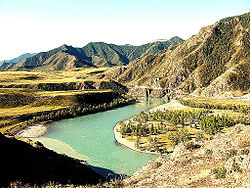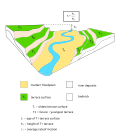Fluvial terrace
Fluvial terrace is an abandoned floodplain with a long, narrow stairs that were formed when the river flowed at a higher level than at present. Fluvial terraces consist of two parts; a tread, which is the flat surface at the upper side of fluvial terrace, and a scarp, which is the steep slope connecting the tread to the downside.
Classification
Fluvial terraces are divided into Rock terraces or gravel terraces according to structure materials. They are classified as Tectonic terraces or Climate terraces depending on how they were formed.
Erosional terraces are terraces where the tread has been formed primarily by lateral erosion. During a low water level stage, fine sediment is deposited and coarse sediment is deposited at the end of a high water event. When the river reaches its highest level, it moves all the channel sediment and scours the underlying bedrock before coarse detritus is deposited again on the channel floor.
Depositional terraces are terraces where the tread represents the surface of a valley fill. Valley filling occurs when the amount of sediment produced in a basin is more than the river system can carry away. It is usually triggered by glacial outwash, climate change, or change in base level, slope, or load caused by rising water level. Depositional terraces are climatically controlled. Erosional terraces are tectonically controlled..[1]
Fluvial Terrace Media
Eroded alluvial fill 60 feet (18 m) thick at Kanab Creek, Kane County, Utah. In 1884 the stream ran at top of the terrace. 1939 photo by United States Geological Survey.
Unpaired fluvial terraces on the South Fork of the Shoshone River, Park County, Wyoming, 1923. The river at left has encountered a formation of erosion-resistant volcanic breccia, causing it to downcut more rapidly on the right, leaving terraces of different elevations.
The Rio Grande, flowing down through the Rio Grande Rift for the last several million years. The last stage of incision by the river is thought to be driven by the Milankovitch eccentricity cycle. Increased precipitation and sediment supply drove incision of the high standing terraces, beginning at ~800ka.
A satellite image of the Himalayas and the rainshadow effect. Development of the Himalayan front and South Asian Monsoon is thought to be driven by tectonic-climatic interactions.
References
- ↑ M. S. Rawat, Environmental Geomorphology and Watershed Management: A Study from Central Himalaya (New Delhi: Concept Publishing Company, 2011), p. 126






